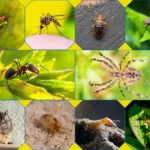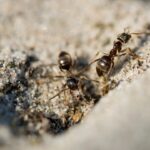These ants are named pissant because they produce urine (piss means urine) like odor when squeezed, and their nest gives the same odor due to the presence of formic acid. Also, pissant are sometimes called sugar ants or pharaoh ants. These are some of the smallest ants when compared with some other types. Find out more about other ants.
Table of contents
Appearance of Pissant
Pissant come in a variety of colors, ranging from pale yellow to reddish-brown to even black, and measure between 1/16 and 1/8 inch in length. Pissant have three pairs of legs and long antennae for scent detection. Their antennae let them detect danger and look for food.
Male ants have black wings, whereas female ants are orange in color. There are markings with bands or patterns on the abdomen of the piss ant. The markings have three segments with a darker finish. They fit easily through tiny gaps because of their small size. They are mainly outdoors, in warmer, moisterous places, and close to supermarkets, lodging facilities, residences, and hospitals.
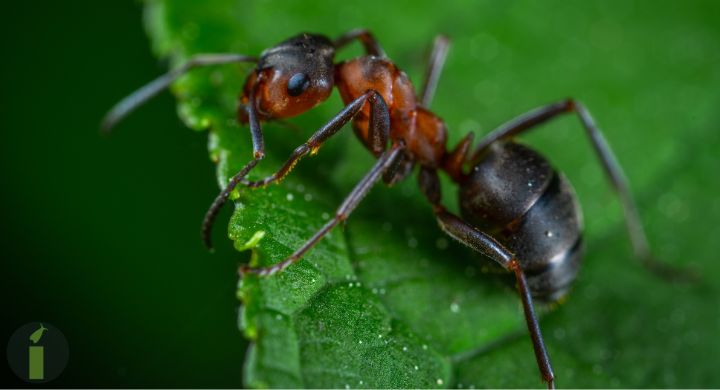
Life Process of Pissant
There are different classes in pissant. Some are workers which are generally smaller, some are soldiers which are bigger. There is a queen in their colony who rules it. Then there is a male for a continuation of the reproductive cycle. There are female workers without wings who do not reproduce. The feminine class performs most of the work. They defend their colony as well.
It takes 45 days for the eggs to develop into larvae. The larvae then grow to become pupae. The pupae then mature into adults. It takes only a single queen to create a new colony as she can lay hundreds of eggs when fertile. Their numbers increase during the spring season. The lifespan of the queen is 12 months that of the male pissant is 5 weeks and the female worker pissant is 10 weeks.

Are Pissants Harmful?
Pissants are not only harmful to your food provisions but also to your home. Pissants have bacteria and viruses that they get from garbage and leftover things. These bacteria and viruses may contaminate your food. Pissants can also infiltrate wooden materials such as closets, furniture, and wooden ceilings. Their rapid multiplication aid in the infestation process.

How to get rid of pissant?
There are several ways to get rid of pissant. Some of them are listed below:
Anti-ant Spray
There is nothing better than an organic solution to the pissant problem. There is an organic insect Repeller by the name of Orange Guard. This spray can help against different types of insects including pissant. You can spray this repellent in pops, in the kitchen, and anywhere in your house that you may find vulnerable.
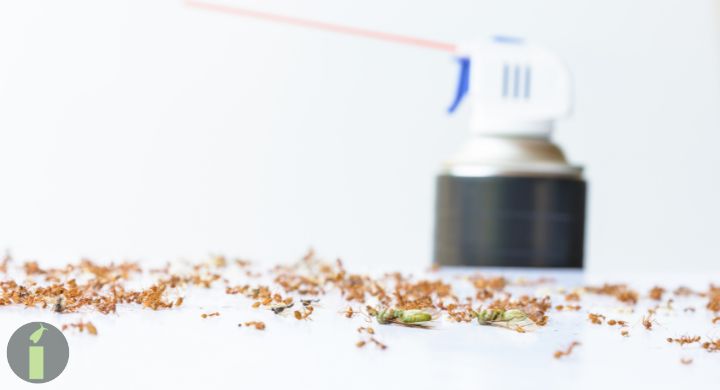
Ant Baits
Ant baits are also great at controlling the pissant population. There are several types of ant baits. Some are fat-based, and some are sugar baits that attract ants as they love sugar. Then there are protein-based baits which are oily. As the queen along with other ants consumes the bait, it will destroy their colony. The basic ingredient of sweet baits is borax. You can easily purchase them from your nearest store. There is another ant bait by the name of Terro Liquid. It’s also very effective. Apply it in the places where you see pissant. It’s a good short-term solution for a pissant problem.

Boric Acid
To control pissant infiltration apply boric acid at cracks and at points where the pissant can enter a building. Boric acid sticks to the legs and antennae of ants, which later on causes poisoning in their stomach. The poisoning causes their death later on.
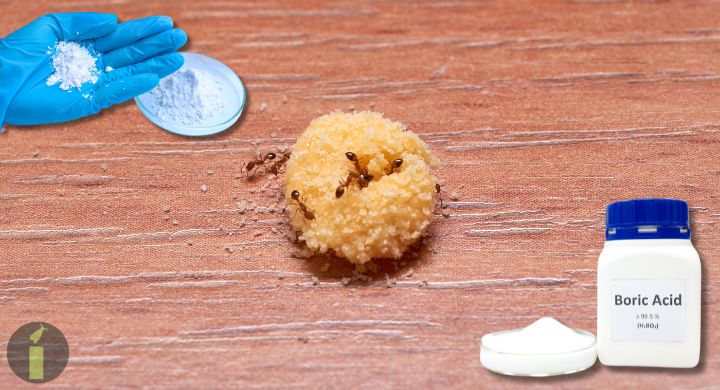
Insect resistant plants
The plantation of herbs assists in keeping pissant away from the building. The use of peppermint and herbaceous flowering plants in the kitchen keeps the ants away. Turmeric, pepper, and cinnamon are also helpful in repelling pissant from your home. The plant releases chemicals that repel the ants. Create a solution using cinnamon, oils from oranges, and peppermint. Use the solution as an insecticide spray.

Earth containing diatomite
Diatomite is an effective, benign, natural, and greener way to repel pissant. Use the power near the ant colonies or at points from where they can enter buildings.
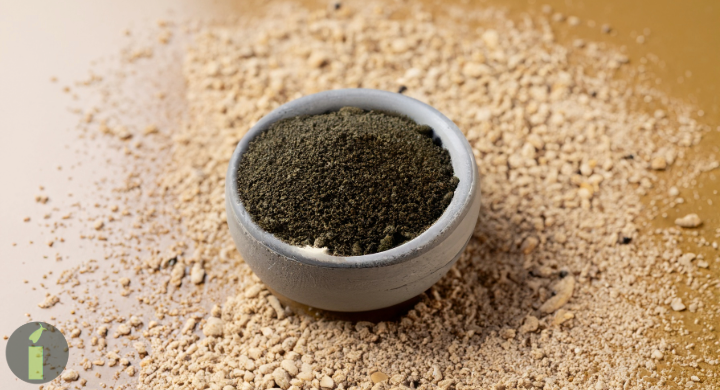
Natural methods to get rid of pissant
There are some natural effective methods that can help in controlling a pissant infestation.
Lemon/ Vinegar Spray
Create a solution of vinegar and water, both in equal amounts. The solution acts as a pissant spray. Use it near entrance points. You can spray it on the insects as well. The spray keeps the pissant from entering your home. A similar solution can be made with lemon. Create a solution of lemon juice and water, twice the amount of the lemon juice. Spray at the affected area. It’s as effective as vinegar spray.

Boric acid + sugar
Add ½ cup of sugar, and 1.5 tbsp of boric acid into one and a half cups of water. Mix them properly to create a solution. Put a cotton ball in the mixture until it’s damp. Place the cotton balls around places where there is an infestation of pissant.
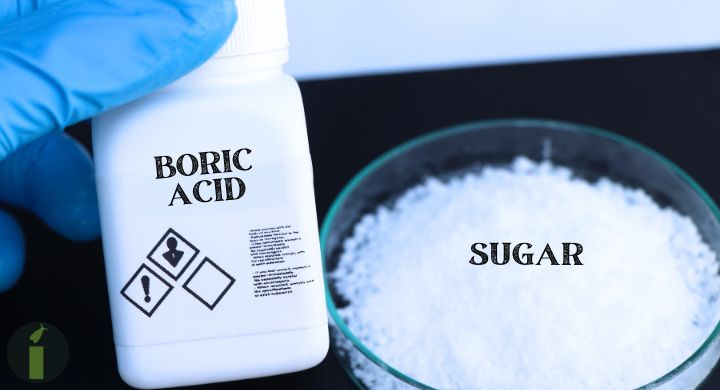
Spray of soap
Add 1 tbsp of dishwash soap to 1 cup vegetable oil and create a mixture. Add 2 tbsp of the mixture to water to create the spray. Use the spray at the entrance points of the pissant. The spray causes the slow death of pissant.

Corn Starch
Place corn starch near pissant colonies. If they eat the starch, they will die.

Aromatic Plants
Certain odors keep the pissant away such as cloves, bay leaves, and garlic. The smells of these plants keep the pissant away from your place.

Coffee
Ground the coffee and spread it where needed. Ground coffee’s smell keeps the pissant away from your home.

Pissant prevention checklist
We are providing a quick checklist for preventing pissant from infesting your place. Apply these measures during the spring season as they appear during that season.
- The kitchen and bathrooms are their favorite places as they like water and darkness. Keep your place tidy and clean damp places.
- Pissant like leftover food. Clear your kitchen or room of leftover foods to avoid their attraction.
- Seal the garbage bags properly and dispose of them in time.
- Seal any cracks or pits in your place
Does pissant bite?
Pissants generally don’t pose a risk to humans. However, they have sturdy jaws and can bite you which can be painful. After a bite, they leave formic acid on the skin which may cause an allergic reaction.
How to treat pissant bite?
Use ice packs on the affected area for around half an hour. It will decrease the bump. Use any antihistamine drug to treat the allergy caused by the bite.
Conclusion
Pissants have a sugar tooth so keep leftover food especially sweet away from your place. Pissants carry bacteria and viruses so keeping them away from your home can prevent diseases. Keep your place tidy to keep the ants away from your place. Use baits or insecticides to get rid of pissant, if you have an infestation. Take professional help if you have an excessive population of pissants.
Stay tuned to insectinsider to learn more about insects that may affect you.
Frequently Asked Questions (FAQs) about Pissant
Q1. How do I get rid of sugar ants permanently?
Speak with an expert! You can attempt a lot of do-it-yourself choices, but they probably won’t produce results that last. Making a call to a licensed exterminator is the best course of action that ensures durable outcomes. They’ll be able to find the colony and eliminate it from its origin.
Q2. What is the best killer of sugar ants?
Use 100% vinegar or create a solution with water. You can safely spray this around your house and in the locations where you notice these sugar ants. Not only will this kill them, but it also acts as a natural repellent to stop such incursions in the future.
Q3. What is the scientific name of the pissant?
Scientific name: Solenopsis molesta; common name: Thief ant (also known as sugar ant, grease ant, or piss ant). Order and Family: Formicidae family; Order Hymenoptera.
Q4. Are sugar ants harmful?
These ants like sugar that’s why they are called sugar ants. While they may swarm your place however they are not very harmful. They generally don’t bite, however, you may need to control the infestation to get rid of them.
Q5. What attracts sugar ants?
Anything that contains sugar attracts sugar ants such as honey, jam, jelly, etc.


